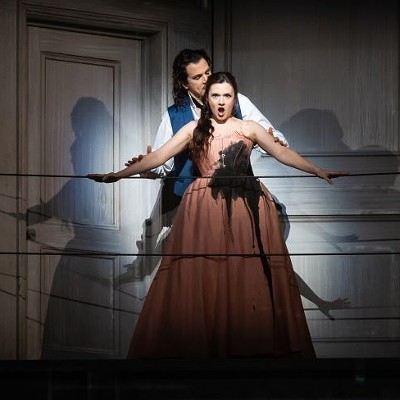The sun sets slowly into the Pacific. Gorgeous pink and orange deepen to lush purple and black. Diagonals from upper left to lower right emphasize the sinking sun and the deepening color. An unsexed voice – that of the singer Nico – drones a mesmerizing (nearly annoying) strain:
He walks alone.
He walks upon the sea.
The sea is black.
It is black.
It is, it is,
And it burns, and it burns,
It burns his white skin.
You may be either disappointed or delighted to hear that Andy Warhol’s film Sunset, which is being screened at The Menil Collection at sunset (or, to be more precise, 6 p.m.) every day the museum is open until January 8, 2017, is only 33 minutes long. Those who find his Empire – “eight hours and five minutes of continuous slow motion footage of the Empire State Building in New York City” – and his Sleep – “consisting of long take footage of John Giorno, his close friend at the time, sleeping for five hours and 20 minutes” – riveting will be among the disappointed. Though in Andy’s defense, it should be noted that Sunset is unfinished. He never captured a sunset that quite satisfied him.
Those who found that they longed to throw themselves from the observation deck of the Empire State Building or that they were asleep themselves, well before the midpoint of either Empire or Sleep, will be delighted. Either way they will have some reaction. It’s those few who are completely indifferent to the 33-minutes news – sort of like the undecideds in the current presidential election – that I may influence by what follows, if they haven’t fallen asleep already.
Sunset was commissioned by John and Dominique de Menil back in the 1960s. The couple, who became major collectors of Warhol’s work, asked him – a fellow Roman Catholic who is reported to have been a devout believer – to make a film with “spiritual significance.” They intended to include it in an exhibition of contemporary art in an ecumenical chapel sponsored by the Catholic Church (is that a non sequitur?) at HemisFair ’68 in San Antonio. The chapel didn’t happen and the film was never finished (no cause and effect connection that I know of), but conceptually the project was in some respects a prelude to the Rothko Chapel.
Even to a non-Catholic, the Catholic influence seems clear:
You are the light.
You are always right.
Death wants to be here at all times.
I’ve been around long enough to remember when Sleep (1963) and Empire (1964) were relatively new. I remember hearing them talked about a few years after they were made. I wasn’t in New York, so it took a while for the news to filter west, though even in New York acceptance wasn’t immediate, even among the nine cutting-edge cinephiles who attended the premiere of Sleep, two of whom left during the first hour (paraphrased from Wikipedia). No word on how many fell asleep.
Though they didn’t create quite the buzz of his oh so risqué Chelsea Girls a couple of years later – my, how “risqué” has changed – they still got talked about by the insiders of the long-haired, artsy set of which I aspired to become a part. “Apart” being the operative word – aspiration never realized.
Houston socialite and art-and-society-world insider Lynn Wyatt attended the press screening of Sunset at the Menil recently. She was, of course, the best-dressed person in attendance. And she had the best posture sitting for a long stretch that I’ve ever seen. Watching her watching made me want to sit up straight (and lose weight). Yes, I admit that my eye wandered from the screen at times – just as my mind wandered from the constant drip of the poetry.
Drone, drone.
Drone, drone,? drone, drone.
Eavesdropping on Wyatt’s pre-screening conversation with another, unrecognized attendee was a little fascinating:
Unrecognized: Did you know Warhol?
LW, with a surprisingly Texas drawl: Yes, he was my boyfriend. [Note: I’m sure Oscar had no reason to worry.] He was so shy. You’d say something and he’d say “Oh, gee.”
Unrecognized: He did your portrait?
LW: Yes, four. But for him it was two were one. There’s one in Geneva … yes, Geneva, and the other in New York, but they really belong together.
Which brought to mind Warhol’s other portraits of Houston women: Caroline Wiess Law, whose four-panel portrait is on view right now at the Museum of Fine Arts, Houston – to which she left it, along with other art and half a billion dollars, when she died in 2004; Jermayne MacAgy, art curator extraordinaire who deserves to be better known, the portrait of whom was commissioned by Dominique de Menil in 1968, after MacAgy’s early death; and, of course, that of Dominique herself. As we now know, in the 1960s Warhol quickly became a major sensation, and he has remained one. That’s one reason Sunset in Houston, a Warhol film that’s hardly been seen before, is big. [Full disclosure: I have a collection, gathered decades ago from used book stores, of books in jackets designed by Warhol back in his pre-fame, ad-man days of the 1950s.]
And now for a few words on the action of Sunset. There are two jets that streak across the horizon. I’m not exactly sure when. Maybe at minutes 13 and 22. Only a guess. This provides the human presence, according to Menil curator Michelle White. Once the camera wobbles and the shot jumps straight up into the sky. And there’s a black filament in the print in the upper right – a flaw that persists throughout the film – which I could hardly stop looking at.
But the real action comes with the flashes of white flecks across the bottom – more flaws that make the experience of watching old-timey real. This is not a restored digital remastering. This is film going through a projector. It comes on reels; it requires a projectionist; it makes noise as it plays. This is as old-and-new as vinyl on a turntable, and the Menil is spending a lot of space and money to show it the way it should be shown. For that, if for nothing else, we have to thank them.
But in fact there may be more than that to thank them for. You may have guessed that I was a skeptic when the lights dimmed, and for many minutes thereafter. Thank God for that black filament and the jet planes. But as the film and the voice droned on, I began to have a sense of freedom that became disarmingly calming. I can’t claim that I ever got to “spiritual,” but I haven’t had a lot of experience with that, so maybe.
And then at 33 minutes the lights went up and they served drinks. I noticed that they didn’t do that before the screening. We had to earn our liquor, as Orwell’s tramps earned their tea in Down and Out in Paris and London, by enduring the sermon first. (Would you guess that I’ve just been reading Orwell?) But when it was over, I found that it hadn’t been such an ordeal. I don’t know how I’d have felt if it had gone on to minute 34. Maybe I would have murmured – as another viewer did – “Genius, profound.” Or maybe I would have bolted for the door, drinks be damned.
Probably not. In my experience, even visual art comes in poetry and prose, and I incline toward the prose kind. But by the end of Sunset I was sort of into poetry. Not to the “profound” level, but at least as far as “maybe this isn’t entirely airy fairy bullshit crap.”
I’m still thinking about it 12 hours later; smiling a little as I think; thinking I may want to go back. Not right away; maybe later on, when the sunset gets a little earlier – though I suppose even then this one won’t sink into the Pacific any faster.
And I may have to put my fingers in my ears for some of it:
Death – wants – to – be – here.
Death – wants – to – be – you.
That’s hitting a little too close to home at my age.
“Andy Warhol: Sunset”
Through January 8, 2017, The Menil Collection, 1515 Sul Ross, 713-525-9400, menil.org.
Support Us
Houston's independent source of
local news and culture
account
- Welcome,
Insider - Login
- My Account
- My Newsletters
- Contribute
- Contact Us
- Sign out
[
{
"name": "Related Stories / Support Us Combo",
"component": "11591218",
"insertPoint": "4",
"requiredCountToDisplay": "4"
},{
"name": "Air - Billboard - Inline Content",
"component": "11591214",
"insertPoint": "2/3",
"requiredCountToDisplay": "7"
},{
"name": "R1 - Beta - Mobile Only",
"component": "12287027",
"insertPoint": "8",
"requiredCountToDisplay": "8"
},{
"name": "Air - MediumRectangle - Inline Content - Mobile Display Size 2",
"component": "11591215",
"insertPoint": "12",
"requiredCountToDisplay": "12"
},{
"name": "Air - MediumRectangle - Inline Content - Mobile Display Size 2",
"component": "11591215",
"insertPoint": "4th",
"startingPoint": "16",
"requiredCountToDisplay": "12"
}
,{
"name": "RevContent - In Article",
"component": "12527128",
"insertPoint": "3/5",
"requiredCountToDisplay": "5"
}
]
KEEP THE HOUSTON PRESS FREE...
Since we started the Houston Press, it has been defined as the free, independent voice of Houston, and we'd like to keep it that way. With local media under siege, it's more important than ever for us to rally support behind funding our local journalism. You can help by participating in our "I Support" program, allowing us to keep offering readers access to our incisive coverage of local news, food and culture with no paywalls.
Randy Tibbits is an independent art writer and curator, specializing in the art history of Houston. He is a member of the Board of Directors of CASETA: Center for the Advancement and Study of Early Texas Art and the coordinator of HETAG: Houston Earlier Texas Art Group. He writes art exhibition reviews for Houston Press from time to time.
Trending Arts & Culture
- Fallout Successfully Makes the Transition From Video Game to Streaming Show
- The 10 Best And Most Controversial Hustler Magazine Covers Ever (NSFW)
- Love is in the Alley's Charming Production of Brontë Classic Jane Eyre
-
Sponsored Content From: [%sponsoredBy%]
[%title%]

Don't Miss Out
SIGN UP for the latest
arts & culture
news, free stuff and more!
Become a member to support the independent voice of Houston
and help keep the future of the Houston Press FREE
Use of this website constitutes acceptance of our
terms of use,
our cookies policy, and our
privacy policy
The Houston Press may earn a portion of sales from products & services purchased through links on our site from our
affiliate partners.
©2024
Houston Press, LP. All rights reserved.





